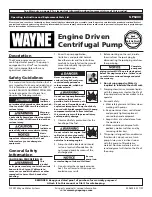
34
Multi F Ceiling Cassette Indoor Unit
Due to our policy of continuous product innovation, some specifications may change without notification.
©LG Electronics U.S.A., Inc., Englewood Cliffs, NJ. All rights reserved. “LG” is a registered trademark of LG Corp.
MAX
MULTI
F
MULTI
F
Figure 41: Tightening the Ring Terminal to the
Terminal Plate.
Power Wiring / Communication Cable Connections
Best practice dictates using solderless ring or fork terminals at all power wiring and com-
munication cable terminations. Use copper bearing ring or fork terminals;
do not use
galvanized or nickel plate over steel. Use appropriate crimping tool to attach the ring or fork
terminals at all power wiring and control cable terminations.
To Install a Ring or Fork Terminal:
1. Trim the wiring with wire cutters or pliers, then strip the insulation to expose the strand
wiring to about 3/8 inches.
2. Using a ring terminal fastener or pliers, securely clamp a ring terminal to each stripped
wire end.
Ring Terminal
Power Wiring
Figure 42: Close up of a Typical Ring Terminal.
Strip to 3/8"
Ring
Terminal
Connecting Cable
Connecting cable
Loosening the
terminal block
screw
Fastening the
wiring tightly
Figure 43: Adding a Ring Terminal to the
Wiring.
To Connect the Wiring to the Terminals:
1. Remove the JIS terminal screws from the (outdoor unit, branch distribution unit, or indoor
unit) terminal plate with a JIS screwdriver. (See information about LG terminal connec-
tions on the next page.)
2. Position the ring terminal around the terminal, place the terminal screw in the ring, and
tighten to the terminal plate using a JIS screwdriver.
• Firmly attach the wire; secure in a way to prevent external forces from being imparted to
the terminal block.
• Use an appropriately sized JIS screwdriver for tightening the terminals.
•
Do not over tighten the connections; over tightening will damage the terminals.
If ring terminals or fork terminals are not available, then:
•
Do not terminate different gauge wires to the power terminal block. (Slack in the
wiring will generate heat.)
• When terminating wires of the same thickness, follow the instructions demonstrated in
the figures below.
•
Never apply line voltage power to the communications cable terminal block. If contact is made, the PCBs will be damaged.
• Always include some allowance in the wiring length when terminating. Firmly attach the wiring or cable, but provide some slack to facilitate
removing the electrical panels while servicing, and to prevent external forces from damaging the terminal block.
•
Never ground the shield of the communications cable to the indoor unit frame or other grounded entities of the building. Ground the
communications cable shield only at the outdoor unit. Improperly grounding this cable can cause communications errors.
:Copper Wire
Terminate multiple power wires of
the same gauge to both sides.
Do not terminate two wires on
one side.
Do not terminate different gauge
wires to a terminal block.
,ISRZHUZLUHVDUHQRWSURSHUO\WHUPLQDWHGDQG¿UPO\DWWDFKHGWKHUHLVULVNRI¿UHHOHFWULFVKRFNDQGSK\VLFDOLQMXU\RUGHDWK
WARNING
Figure 44: Proper and Improper Power Wiring Connections.
Power Wiring / Communication Cable Connections
WIRING
















































